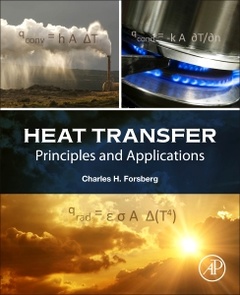Description
Heat Transfer Principles and Applications
Author: Forsberg Charles H.
Language: English
Subject for Heat Transfer Principles and Applications:
562 p. · 19x23.3 cm · Paperback
Description
/li>Contents
/li>Readership
/li>Biography
/li>Comment
/li>
Heat Transfer Principles and Applications is a welcome change from more encyclopedic volumes exploring heat transfer. This shorter text fully explains the fundamentals of heat transfer, including heat conduction, convection, radiation and heat exchangers. The fundamentals are then applied to a variety of engineering examples, including topics of special and current interest like solar collectors, cooling of electronic equipment, and energy conservation in buildings. The text covers both analytical and numerical solutions to heat transfer problems and makes considerable use of Excel and MATLAB® in the solutions. Each chapter has several example problems and a large, but not overwhelming, number of end-of-chapter problems.
- A medium-sized text providing a thorough treatment of heat transfer fundamentals
- Includes both analytical and numerical solutions of heat transfer problems
- Extensive use of Excel and Matlab
- Includes a chapter on mass transfer
- Includes a unique chapter of multimode problems to enhance the students problem-solving skills. Minimal information is given in the problem statements. Students must determine the relevant modes of heat transfer (conduction, convection, radiation) and, using the earlier chapters, must determine the appropriate solution technique. For example, they must decide whether the problem is steady-state or transient. They must determine the applicable convection coefficients and material properties. They must decide which solution approach (e. g., analytical or numerical) is appropriate




